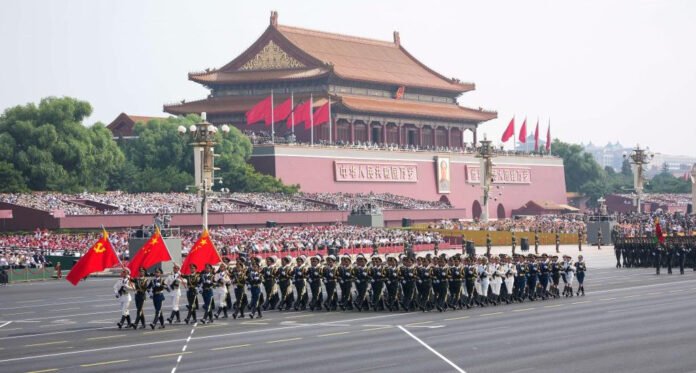China’s 80th WWII parade showcased advanced multi-domain weapons, highlighting rapid military growth and potential strategic threats to India.
Airspace Domain
The parade featured state-of-the-art fighter aircraft, drones, and missile systems that demonstrated China’s air capabilities. The J-20 and the J-35, which are sophisticated stealth fighters, were prominently displayed, demonstrating China’s capacity to confront regional and global air powers. The parade also showcased airborne early warning aircraft, such as the KJ500A, which improve China’s surveillance and command capabilities.
Unmanned aerial vehicles (UAVs) took centre stage. The GJ-11 and other AI-powered stealth attack drones are intended to operate in conjunction with manned aircraft, providing support for target engagement and reconnaissance. Conventional drones were also on exhibit, which served to emphasise China’s emphasis on precision strikes and battlefield surveillance. The LY-1 laser weapon, which is mounted on mobile platforms, is designed to blind pilots and disable adversary sensors, thereby potentially weakening India’s aerial reconnaissance and defence systems.
Hypersonic air-to-ship and air-to-surface missiles such as the YJ-15 were among the featured advanced weapons. These missiles are capable of evasive manoeuvres and travel at an incredibly high speed, rendering them difficult to intercept and particularly dangerous to Indian naval and coastal defences.
The parade featured state-of-the-art fighter aircraft, drones, and missile systems that demonstrated China’s air capabilities. The J-20 and the J-35, which are sophisticated stealth fighters, were prominently displayed, demonstrating China’s capacity to confront regional and global air powers
Land Domain
China demonstrated its most advanced missile systems and armoured vehicles, emphasizing improvements in survivability, mobility, and firepower. The Type 99A main battle tank, which is equipped with a 125 mm smoothbore gun and sophisticated protection systems, continues to be a fundamental component of China’s armoured forces. It presents a significant challenge to Indian ground forces, particularly in contested border areas.
ZTL11 wheeled assault weapons and ZBL09 amphibious vehicles offer rapid response capabilities and versatile fire support, making them suitable for various terrains, including the mountainous regions near the India-China border.
The parade prominently featured nuclear-capable intercontinental ballistic missiles (ICBMs), such as the silo-based DF-5C and the mobile DF-61, as well as variants of the DF-31 series. The DF-5C is capable of delivering numerous payloads and boasts a global strike range. The mobility of the DF-61 enhances its survivability, making it more challenging to target. The threat reach of these missiles is extended to virtually all regions, including India, and China’s strategic deterrent is strengthened significantly.
China highlighted its expanding naval power with advanced missile and unmanned underwater vehicle systems. China demonstrated the JL-3 submarine-launched ballistic missile (SLBM), a critical nuclear-capable asset. This missile completes China’s nuclear triumvirate by complementing land- and air-based nuclear delivery platforms
The LY-1 high-energy laser weapon on armoured trucks was displayed for the first time. Its function is to damage sensors to neutralise drones and incoming missiles, providing China with a cost-effective countermeasure to emergent aerial threats that India may also encounter.
Domain of the Sea
China highlighted its expanding naval power with advanced missile and unmanned underwater vehicle systems. China demonstrated the JL-3 submarine-launched ballistic missile (SLBM), a critical nuclear-capable asset. This missile completes China’s nuclear triumvirate by complementing land- and air-based nuclear delivery platforms. The JL-3 is essential for the preservation of credible deterrence by improving second-strike capabilities from the sea.
Large unmanned underwater vehicles such as the AJX002 submarine drone were unveiled. These drones are capable of conducting offensive operations, surveillance, and reconnaissance, which substantially enhances China’s underwater warfare capabilities in the Indian Ocean, a critical region from India’s strategic perspective.

The YJ-17 and other hypersonic anti-ship missiles, which were specifically engineered to strike large naval vessels and aircraft carriers with high speed and agility, were on exhibit. These armaments are a significant threat to the Indian Navy’s surface fleet and could potentially challenge India’s maritime control in the region.
The introduction of new drones, such as the KJ600, significantly enhanced the naval aviation capabilities of Chinese naval forces that operate at sea, providing them with a broader range of reconnaissance and strike options.
Domain of Space
Additionally, China underscored the expansion of its capabilities in the field of space warfare. The HQ-29 space defence system, which is intended to disable or destroy hostile satellites, was demonstrated. This capability poses a threat to India’s dependence on satellites for military surveillance, navigation, and communication, which could potentially disrupt Indian military operations during conflict.
India must prepare for the modern dangers introduced by the deployment of AI-powered drones, robotic systems, and laser weapons to maintain battlefield effectiveness. Cyber warfare and space capabilities could significantly impact India’s capacity to manage intelligence and conduct coordinated military operations during a conflict
For the first time, China showcased its cybersecurity and information warfare divisions in a parade formation, in addition to kinetic space weapons. China dedicates these units to safeguarding its digital battlefield, collecting intelligence, and defending against network attacks. This cyber capability enhances space warfare by focusing on satellite ground stations and critical communication infrastructure.
Threat to India
China’s progress in these areas poses a multifaceted threat to India’s security. The strategic stability of South Asia is complicated by the expansion of China’s nuclear triumvirate through advanced ICBMs and SLBMs, which could potentially lead to an arms race. There is a potential for hypersonic missiles and anti-ship weapons to pose a threat to Indian naval dominance and to important maritime trade routes that are essential to India.
India must prepare for the modern dangers introduced by the deployment of AI-powered drones, robotic systems, and laser weapons to maintain battlefield effectiveness. Cyber warfare and space capabilities could significantly impact India’s capacity to manage intelligence and conduct coordinated military operations during a conflict.
China’s 2025 military parade, in general, showcased a substantial increase in military power, which has the potential to significantly alter regional security dynamics. This has compelled India to improve its own military readiness and technological advantage to confront these emergent threats.
The intent of China to dominate multiple warfare domains and project power regionally and globally is underscored by this comprehensive display, with India positioned as a key strategic competitor.
The writer is the Publisher of Frontier India and the author of the book Foxtrot to Arihant: The Story of Indian Navy’s Submarine Arm.






